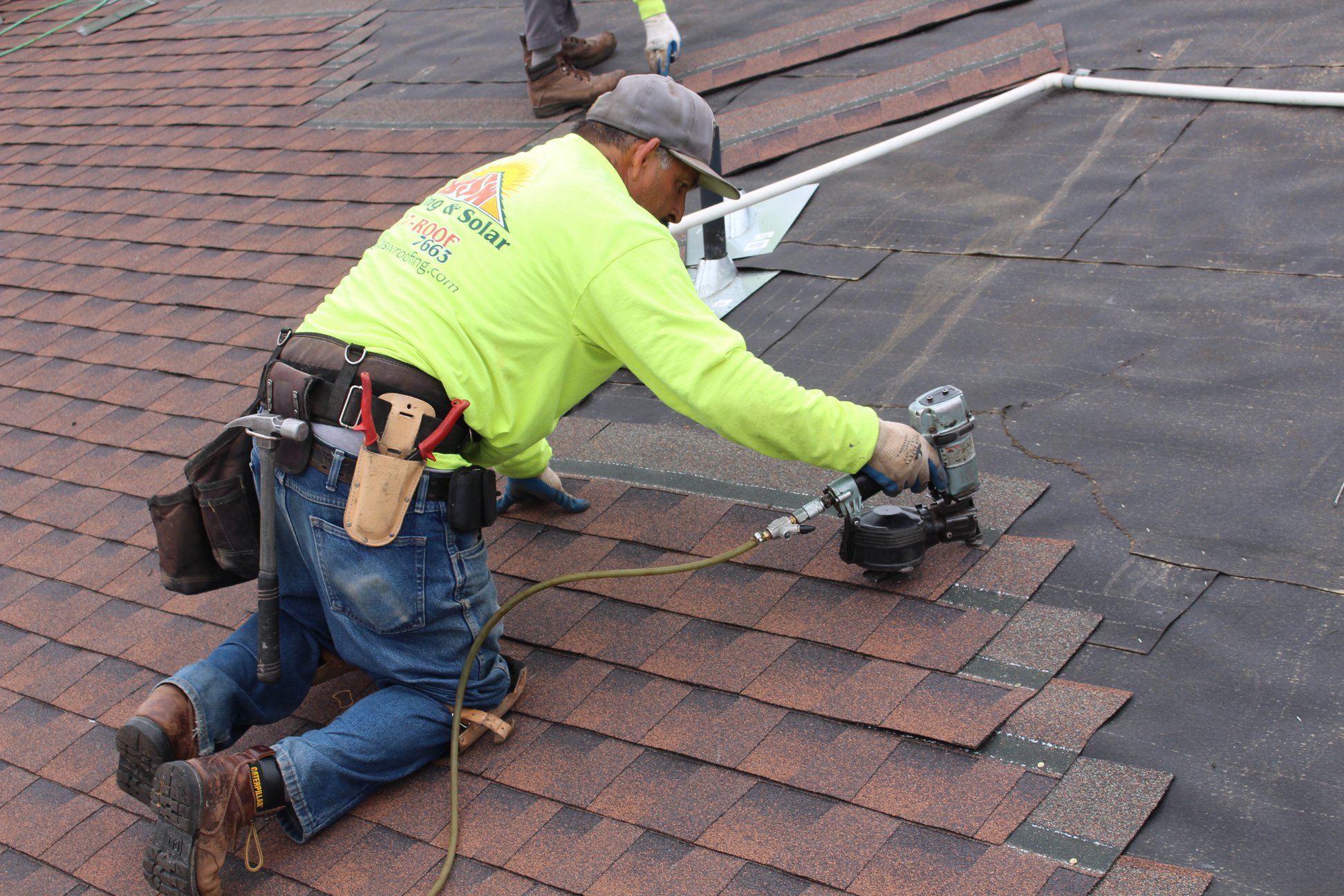A Comprehensive Take A Look At Roofing Companies Gainesville Citizens Recommend
A Comprehensive Take A Look At Roofing Companies Gainesville Citizens Recommend
Blog Article
Best Practices for Ensuring Appropriate Roof Ventilation
Making certain appropriate roof air flow is critical for the long life and performance of a roof system. A well balanced intake and exhaust air vent proportion, typically 1:300, plays a pivotal function, with consumption vents ideally positioned at the reduced edge of the roof for trendy air access and exhaust vents at the optimal for cozy air leave. Routine examinations to recognize obstructions and preserve clear airflow are paramount. In addition, maintaining insulation away from vents is essential to stop airflow constraint. Understanding these fundamental components sets the phase for more in-depth insights right into installment and upkeep techniques that can significantly enhance your roof's performance.
Understand Air Flow Essentials
Properly recognizing ventilation basics is important for making sure the long life and efficiency of roof. Efficient air flow reduces moisture accumulation and temperature extremes in the attic room, both of which can cause considerable architectural damage with time. A well-ventilated roof aids in protecting against usual issues such as mold and mildew development, timber rot, and ice dams, which can endanger the integrity of the roof materials and the underlying frameworks.
The main objective of ventilation is to facilitate the motion of air, permitting for a constant exchange between the outside and interior atmospheres. This equilibrium is attained through a combination of intake and exhaust vents that work together to preserve ideal airflow. Consumption vents, typically located along the eaves or soffits, permit fresh air to get in the attic room space, while exhaust vents, frequently situated at or near the roofing ridge, allow warm, moist air to get away.
Key aspects affecting the performance of roofing system ventilation consist of appropriate placement, appropriate sizing, and making sure that both intake and exhaust vents are unobstructed. Routine assessment and upkeep are crucial to identify possible blockages, damages, or inefficiencies in the air flow system, therefore guarding the roofing system's efficiency and sturdiness.
Sorts Of Roof Covering Vents
Roofing system vents play an important duty in preserving reliable attic air flow and, by expansion, the total wellness of the roof covering system. Various sorts of roof vents are readily available, each with unique benefits customized to specific roof requirements. Ridge vents, for example, are set up along the roofing system's top, permitting cozy, moist air to escape from the attic room. They use constant air flow and blend perfectly with the roofline, making them both efficient and cosmetically pleasing.

Soffit vents are mounted under the eaves and operate in tandem with roofing system vents to make certain a well balanced intake and exhaust system. By permitting cooler air to go into from below, soffit vents assist in the expulsion of warm air through top vents. Gable vents, situated on the outside walls of the attic room, offer one more reliable option, especially in homes with gable roofing systems.
Analyze Your Present Ventilation

Next, consider the age and problem of your roofing products and air flow elements. Older systems may not comply with present building regulations or may have weakened over time, decreasing their efficiency. Conduct a detailed examination to recognize any kind of signs of wear and tear, such as corrosion, damages, or voids that could compromise the system's efficiency.
Additionally, measure the attic room temperature level and moisture levels. High temperatures and humidity can show poor ventilation - roofing companies in gainesville florida. Utilize a hygrometer and thermostat to acquire exact analyses, contrasting them with outdoor conditions. Consistent inconsistencies recommend possible concerns that need attending to.
Installment Best Practices
Reliable setup of roofing ventilation systems is extremely important for making certain ideal efficiency and longevity. Correct installation begins with comprehending the particular go to my blog ventilation needs of the roof and the structure it covers. This involves computing the correct ratio of intake to tire vents, usually sticking to the 1:300 policy, which specifies one square foot of air flow for every 300 square feet of attic room floor area.

The placement of vents is similarly critical. Intake vents need to be set up at the roof's lower side, frequently in the soffits, to permit cool air to go into. Exhaust vents, on the other hand, ought to be installed near or at the roofing's peak to assist in the exit of cozy, moist air. This produces a natural air movement that assists keep temperature and wetness balance within the attic room room.
Seal all air vent connections meticulously to avoid air leaks and potential water seepage. Use top notch products and adhere to producer guidelines to make sure durability and efficiency. In addition, incorporating ridge vents with baffles can considerably boost air movement efficiency by protecting against wind-driven rainfall and snow from going into the attic room.
Inevitably, specific installation of roof air flow systems minimizes prospective issues such as mold and mildew development, ice dams, and architectural damages, ensuring the roofing system's integrity and the structure's overall health.
Regular Upkeep Tips
Uniformity in maintenance techniques is fundamental to making sure the long-term effectiveness of roofing ventilation systems. Throughout these evaluations, make certain that vents are free of particles, nests, and other blockages that could restrain air flow.
Cleaning the vents is one more essential task. Utilize a soft brush or a vacuum to eliminate dust and particles from consumption and exhaust vents. Beware not to damage the vent displays or louvers during the procedure. Additionally, check the attic room room for any kind of indications of water damage, which can compromise the stability of the roofing system.
Proper insulation is just as crucial. Ensure that attic insulation does not block the vents, as this can seriously limit air movement. If any insulation has shifted or settled, reposition or replace it to keep an effective barrier.
Lastly, change any kind of harmed Recommended Site or missing out on parts without delay. Damaged vents, broken roof shingles, or deteriorated blinking can all add to inadequate air flow and needs to be resolved without hold-up. Normal upkeep ensures that the roof covering ventilation system functions optimally, therefore prolonging the life expectancy of the roofing itself.
Verdict
Making certain appropriate roof ventilation is paramount for preserving the performance and durability of a roof covering system. Adherence to the 1:300 consumption and exhaust vent proportion, combined with the strategic positioning of vents, is vital. Routine biannual inspections, particles cleansing, and guaranteeing insulation does not obstruct airflow are critical methods. Executing these best techniques will cultivate a well-ventilated roof covering system, consequently mitigating possible issues her comment is here associated with moisture accumulation and too much warm, inevitably prolonging the roof covering's life expectancy.
A balanced intake and exhaust air vent proportion, commonly 1:300, plays an essential duty, with consumption vents preferably placed at the lower edge of the roof for trendy air entry and exhaust vents at the height for warm air leave. Intake vents, usually located along the soffits or eaves, allow fresh air to get in the attic room room, while exhaust vents, usually situated at or near the roofing ridge, make it possible for warm, humid air to get away.
Soffit vents are mounted under the eaves and job in tandem with roofing system vents to ensure a balanced intake and exhaust system. By enabling cooler air to go into from below, soffit vents promote the expulsion of hot air through upper vents. Adherence to the 1:300 consumption and exhaust vent ratio, combined with the tactical positioning of vents, is important.
Report this page